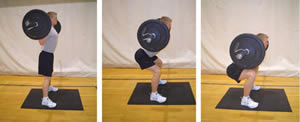The turkish get up is a move that, by comparison to some of the other kettlebell drills, is actually pretty easy to learn – one of the biggest issues seems to be figuring out the ‘proper’ way to do it. Do a quick YouTube search and you’ll get hundreds of videos and dozens of different get up ‘styles’ – everyone seems to be doing it a little differently.
While I’m not convinced there’s one ‘right’ way to do a get up, breaking the movement down into steps does seem to make the learning process a lot easier. Here’s one of the best YouTube videos I’ve found on doing just that:
To re-iterate (I’ve broken it down to 10 steps although the video only mentions 5):
Step 1: Safely bring the kettlebell to the shoulder and press it up over the chest.
Step 2: Right knee comes up if the KB is being held in the right hand.
Step 3: ‘Punch’ towards the sky with the kettlebell. Use your obliques on the right side and drive through the right heel for leverage. As you can see in the video, the movement is more like a roll than a sit up.
Step 4: Continue the movement and come up to the left elbow.
Step 5: Straighten the left elbow. The KB should now be at arms length in front of your body and the left arm should be straight – you’re resting on the left hand. You should be able to hold this postion for a while if you’re doing it right.
Step 6: Pick the body up. I like to do the RKC-style bridge here – but that’s not the version being done in this video.
Step 7: Swing the leg through. Keep looking at the KB.
Step 8: Come up to a knee. Go back and forth through these positions a few times while you’re practicing your form.
Step 9: Stand all the way up.
Step 10: Reverse the entire movment and finish laying on the floor.
This is a great demo of how to do the turkish get up. Breaking the movement down into steps is the best and fastest way to learn it – I know it helped me a lot when I was getting started.
Anthony DiLugo of artofstrength.com is demoing the exercise – find out more about him on his website. You can also check out his DVD’s and other info products on amazon.com by clicking here: The Art of Strength:Providence.
If you enjoyed this post, be sure to subscribe to the kettlebellbasics.net newsletter – just drop your name and email into the box in the upper right hand corner of the page. You’ll get a free KB training video just for signing up!

 The Barbell Back Squat
The Barbell Back Squat The Kettlebell Squat
The Kettlebell Squat